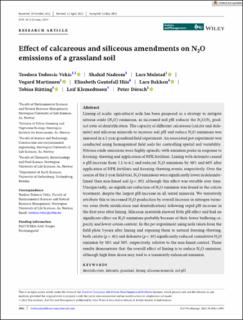| dc.contributor.author | Todorcic Vekic, Teodora | |
| dc.contributor.author | Nadeem, Shahid | |
| dc.contributor.author | Molstad, Lars | |
| dc.contributor.author | Martinsen, Vegard | |
| dc.contributor.author | Hiis, Elisabeth Gautefall | |
| dc.contributor.author | Bakken, Lars | |
| dc.contributor.author | Rütting, Tobias | |
| dc.contributor.author | Klemedtsson, Leif | |
| dc.contributor.author | Dörsch, Peter | |
| dc.date.accessioned | 2024-01-11T12:20:21Z | |
| dc.date.available | 2024-01-11T12:20:21Z | |
| dc.date.created | 2023-08-17T13:12:08Z | |
| dc.date.issued | 2023-05-19 | |
| dc.identifier.citation | Soil use and management. 2023, 39 (3), 1082-1095. | en_US |
| dc.identifier.issn | 0266-0032 | |
| dc.identifier.uri | https://hdl.handle.net/11250/3111100 | |
| dc.description.abstract | Liming of acidic agricultural soils has been proposed as a strategy to mitigate nitrous oxide (N2O) emissions, as increased soil pH reduces the N2O/N2 product ratio of denitrification. The capacity of different calcareous (calcite and dolomite) and siliceous minerals to increase soil pH and reduce N2O emissions was assessed in a 2-year grassland field experiment. An associated pot experiment was conducted using homogenized field soils for controlling spatial soil variability. Nitrous oxide emissions were highly episodic with emission peaks in response to freezing–thawing and application of NPK fertilizer. Liming with dolomite caused a pH increase from 5.1 to 6.2 and reduced N2O emissions by 30% and 60% after application of NPK fertilizer and freezing–thawing events, respectively. Over the course of the 2-year field trial, N2O emissions were significantly lower in dolomite-limed than non-limed soil (p < .05), although this effect was variable over time. Unexpectedly, no significant reduction of N2O emission was found in the calcite treatment, despite the largest pH increase in all tested minerals. We tentatively attribute this to increased N2O production by overall increase in nitrogen turnover rates (both nitrification and denitrification) following rapid pH increase in the first year after liming. Siliceous materials showed little pH effect and had no significant effect on N2O emissions probably because of their lower buffering capacity and lower cation content. In the pot experiment using soils taken from the field plots 3 years after liming and exposing them to natural freezing–thawing, both calcite (p < .01) and dolomite (p < .05) significantly reduced cumulative N2O emission by 50% and 30%, respectively, relative to the non-limed control. These results demonstrate that the overall effect of liming is to reduce N2O emission, although high lime doses may lead to a transiently enhanced emission. | en_US |
| dc.language.iso | eng | en_US |
| dc.publisher | John Wiley & Sons Ltd. on behalf of British Society of Soil Science | en_US |
| dc.rights | Attribution-NonCommercial-NoDerivatives 4.0 Internasjonal | * |
| dc.rights.uri | http://creativecommons.org/licenses/by-nc-nd/4.0/deed.no | * |
| dc.title | Effect of calcareous and siliceous amendments on N2O emissions of a grassland soil | en_US |
| dc.title.alternative | Effect of calcareous and siliceous amendments on N2O emissions of a grassland soil | en_US |
| dc.type | Peer reviewed | en_US |
| dc.type | Journal article | en_US |
| dc.description.version | publishedVersion | en_US |
| dc.rights.holder | © 2023 The Authors | en_US |
| dc.source.pagenumber | 1082-1095 | en_US |
| dc.source.volume | 39 | en_US |
| dc.source.journal | Soil use and management | en_US |
| dc.source.issue | 3 | en_US |
| dc.identifier.doi | 10.1111/sum.12913 | |
| dc.identifier.cristin | 2167682 | |
| dc.relation.project | EC/H2020/696356 | en_US |
| dc.relation.project | Norges forskningsråd: 234382 | en_US |
| cristin.ispublished | true | |
| cristin.fulltext | original | |
| cristin.qualitycode | 1 | |

